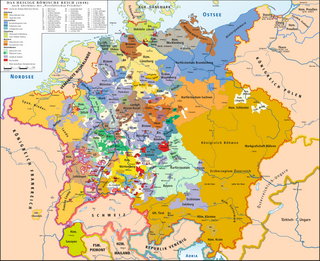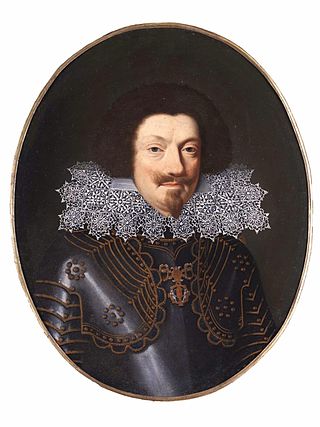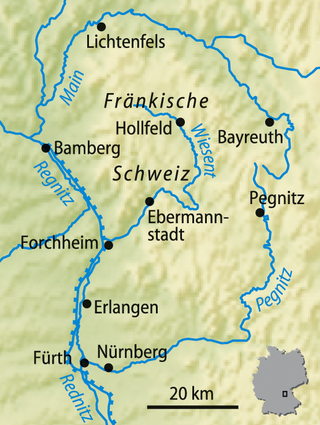
The Thirty Years' War was one of the longest and most destructive conflicts in European history, lasting from 1618 to 1648. Fought primarily in Central Europe, an estimated 4.5 to 8 million soldiers and civilians died as a result of battle, famine, and disease, while some areas of what is now modern Germany experienced population declines of over 50%. Related conflicts include the Eighty Years' War, the War of the Mantuan Succession, the Franco-Spanish War, and the Portuguese Restoration War.

The Battle of Nördlingen took place on 6 September 1634 during the Thirty Years' War. A combined Imperial-Spanish force inflicted a crushing defeat on the Swedish-German army.

Ferdinand II was Holy Roman Emperor, King of Bohemia, Hungary, and Croatia from 1619 until his death in 1637. He was the son of Archduke Charles II of Inner Austria and Maria of Bavaria. His parents were devout Catholics, and, in 1590, they sent him to study at the Jesuits' college in Ingolstadt because they wanted to isolate him from the Lutheran nobles. In July that same year (1590), when Ferdinand was 12 years old, his father died, and he inherited Inner Austria–Styria, Carinthia, Carniola and smaller provinces. His cousin, the childless Rudolf II, Holy Roman Emperor, who was the head of the Habsburg family, appointed regents to administer these lands.

Ferdinand III was from 1621 Archduke of Austria, King of Hungary from 1625, King of Croatia and Bohemia from 1627 and Holy Roman Emperor from 1637 until his death in 1657.

Frederick V was the Elector Palatine of the Rhine in the Holy Roman Empire from 1610 to 1623, and reigned as King of Bohemia from 1619 to 1620. He was forced to abdicate both roles, and the brevity of his reign in Bohemia earned him the derisive sobriquet "the Winter King".

The Catholic League was a coalition of Catholic states of the Holy Roman Empire formed 10 July 1609. While initially formed as a confederation to act politically to negotiate issues vis-à-vis the Protestant Union, modelled on the more intransigent ultra-Catholic French Catholic League (1576), it was subsequently concluded as a military alliance "for the defence of the Catholic religion and peace within the Empire".

The Protestant Union, also known as the Evangelical Union, Union of Auhausen, German Union or the Protestant Action Party, was a coalition of Protestant German states. It was formed on 14 May 1608 by Frederick IV, Elector Palatine in order to defend the rights, land and safety of each member. It included both Calvinist and Lutheran states, and dissolved in 1621.

Maximilian I, occasionally called the Great, a member of the House of Wittelsbach, ruled as Duke of Bavaria from 1597. His reign was marked by the Thirty Years' War during which he obtained the title of a Prince-elector of the Holy Roman Empire at the 1623 Diet of Regensburg.

John George I was Elector of Saxony from 1611 to 1656. He led Saxony through the Thirty Years' War, which dominated his 45 year reign.

The Peace of Prague, signed on 30 May 1635, ended Saxony's participation in the Thirty Years War. Other German princes subsequently joined the treaty and although the Thirty Years War continued, it is generally agreed Prague ended it as a war of religion within the Holy Roman Empire. Thereafter, the conflict was largely driven by foreign powers, including Spain, Sweden, and France.

The Heilbronn League was formed in the Free Imperial City of Heilbronn, on 23 April 1633, during the Thirty Years' War. Led by Sweden, it brought together various Protestant states in western and northern Germany. It was supported by Saxony and Brandenburg-Prussia, although they were not members.

The Battle of Jankau, also known as Jankov, Jankow, or Jankowitz, took place in central Bohemia, on 6 March 1645. One of the last major battles of the 1618 to 1648 Thirty Years' War, it was fought between Swedish and Imperial armies, each containing around 16,000 men. The more mobile and better led Swedes under Lennart Torstensson effectively destroyed their opponents, commanded by Melchior von Hatzfeldt. However, the devastation caused by decades of conflict meant armies now spent much of their time obtaining supplies, and the Swedes were unable to take advantage.

The War of the Mantuan Succession (1628–1631) was a related conflict of the Thirty Years' War, caused by the death in December 1627 of Vincenzo II, last male heir in the direct line of the House of Gonzaga and ruler of the duchies of Mantua and Montferrat. These territories were key to control of the Spanish Road, an overland route that allowed Habsburg Spain to move recruits and supplies from Italy to their army in Flanders. The result was a proxy war between France, who supported the French-born Duke of Nevers, and Spain, who backed his distant cousin the Duke of Guastalla.

The Electorate of Bavaria was an independent hereditary electorate of the Holy Roman Empire from 1623 to 1806, when it was succeeded by the Kingdom of Bavaria.

The Battle of Herbsthausen, also known as the Battle of Mergentheim, took place near Bad Mergentheim, in the modern German state of Baden-Württemberg. Fought on 5 May 1645, during the Thirty Years War, it featured a French army led by Turenne, defeated by a Bavarian force under Franz von Mercy.

The Treaty of Bärwalde, signed on 23 January 1631, was an agreement by France to provide Sweden financial support, following its intervention in the Thirty Years' War.
The Palatinate campaign, also known as the Spanish conquest of the Palatinate or the Palatinate phase of the Thirty Years' War was a campaign conducted by the Imperial army against the Protestant Union in the Lower Palatinate, during the Thirty Years' War.

The Diet of Regensburg of 1623 was a meeting of the Imperial States of the Holy Roman Empire convened by Holy Roman Emperor Ferdinand II. The meeting was not technically an imperial diet in the full sense, but a convention of princes or Deputationstag – a looser constitutional format giving the emperor greater leeway to take decisions without being bound by formal procedures. At it the Electorate of the Palatinate was transferred to Maximilian I of Bavaria. The meeting marked the high-water mark of imperial power during the Thirty Years' War.

The Battle of Fürth was fought on September 3, 1632 between the Catholic forces of Holy Roman Emperor Ferdinand II and the Protestant forces of King Gustavus II of Sweden during the period of Swedish intervention in the Thirty Years War.
The imperial election of 1653 was an imperial election held to select the emperor of the Holy Roman Empire. It took place in Augsburg on May 31.




















